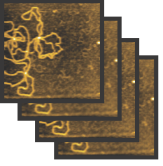
Blind people often use canes to scan the surface of streets and detect objects in their path, characterize the objects, and generate a mental image. Similarly, the atomic force microscope (AFM) probes the surface of a molecule with a sharp tip to generate an image without directly viewing the tiny structure. However, traditional AFMs take minutes to produce a single image, far too slow to resolve biomolecular processes, which happen in milliseconds. This limitation has recently been overcome with the development of high-speed AFM (HS-AFM) in Japan, which can generate up to 20 images per second. “The HS-AFM is at least 800 times faster than the conventional AFM,” says Bibiana Onoa, an associate researcher in Professor Carlos Bustamante’s lab, and coordinator of the brand new HS-AFM facility at UC Berkeley. “We are very excited because we expect to unveil aspects by which molecules operate and interact that were not accessible with other tools due to their short duration.”
 Credit: Bibiana Onoa
Credit: Bibiana Onoa
One such process is transcription, in which an enzyme called RNA polymerase (RNAp) binds to a DNA molecule and copies it into RNA. An individual human cell contains about two meters of DNA, all of which needs to fit inside the cell’s microscopic volume. To accomplish this, a segment of a DNA molecule wraps around eight proteins called histones, creating a compact bundle known as a nucleosome. This efficient packaging comes at a cost, however, as nucleosomes constitute a barrier to the operation of RNAp that can turn off certain genes. In response, cells have developed mechanisms, like chemical modification of individual histone proteins, in order to allow transcription to proceed. Until now, the dynamics of these mechanisms has been difficult to observe, limiting scientific understanding of transcription and gene regulation.
Onoa and her colleagues looked at nucleosomes using the HS-AFM and were able to observe the dynamics of individual histones for the first time. At a moderate rate of 3 images per second, they saw at least two of the eight histones disassemble from the nucleosome core, diffuse along the DNA, and then re-assemble. Faster scans should enable more insights about nucleosome dynamics, which is why Onoa and her colleagues are currently optimizing their HS-AFM to obtain speeds of five to ten images per second. At these speeds, they hope to observe how specific enzymes modify the nucleosome to further facilitate transcription.
This article is part of the Fall 2013 issue.



